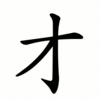才
| ||||||||
Translingual
| Stroke order | |||
|---|---|---|---|
 | |||
Han character
才 (radical 64, 手+0, 3 strokes, cangjie input 木竹 (DH), four-corner 40200, composition ⿹𬺰丿(GHTV) or ⿻𬺰丿(JK))
References
- KangXi: page 416, character 30
- Dai Kanwa Jiten: character 11769
- Dae Jaweon: page 763, character 1
- Hanyu Da Zidian: volume 3, page 1824, character 2
- Unihan data for U+624D
Chinese
Glyph origin
| Historical forms of the character 才 | |||
|---|---|---|---|
| Shang | Western Zhou | Shuowen Jiezi (compiled in Han) | Liushutong (compiled in Ming) |
| Oracle bone script | Bronze inscriptions | Small seal script | Transcribed ancient scripts |
 |
 |
 |
 |
| Characters in the same phonetic series (才) (Zhengzhang, 2003) | |
|---|---|
| Old Chinese | |
| 茬 | *zraː, *zraːʔ, *ʔsrɯ, *zrɯ |
| 材 | *zlɯː |
| 才 | *zlɯː, *zlɯːs |
| 財 | *zlɯː |
| 鼒 | *zlɯː, *ʔslɯ |
| 在 | *zlɯːʔ, *zlɯːs |
| 豺 | *zrɯː |
Pictogram (象形) – sprouting of seeds.
Etymology 1
| simp. and trad. |
才 | |
|---|---|---|
Derivatives: 材 (OC *zlɯː, “material; timber”), 財 (OC *zlɯː, “riches; property; money”).
Pronunciation
Definitions
才
Compounds
Derived terms from 才
|
|
|
Pronunciation
Definitions
才
Pronunciation
Synonyms
- (just now):
Synonyms of 才
Compounds
Derived terms from 才
|
|
|
Further reading
- “Entry #215”, in 臺灣閩南語常用詞辭典 [Dictionary of Frequently-Used Taiwan Minnan] (in Chinese and Min Nan), Ministry of Education, R.O.C., 2011.
Japanese
Compounds
- 才覚 (saikaku)
- 才気 (saiki)
- 才能 (sainō)
- 漫才 (manzai): a style of double act stand-up comedy
Vietnamese
Han character
才 (tài)
- This term needs a translation to English. Please help out and add a translation, then remove the text
{{rfdef}}.
This article is issued from
Wiktionary.
The text is licensed under Creative
Commons - Attribution - Sharealike.
Additional terms may apply for the media files.